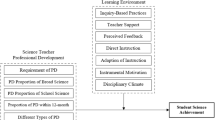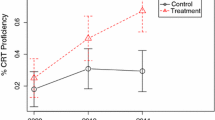Abstract
This study investigated the effectiveness of a southern state’s department of education program to improve science achievement through embedded professional development of science teachers in the lowest performing schools. The Science Mentor Program provided content and inquiry-based coaching by teacher leaders to science teachers in their own classrooms. The study analyzed the mean scale scores for the science portion of the state’s high school graduation test for the years 2004 through 2007 to determine whether schools receiving the intervention scored significantly higher than comparison schools receiving no intervention. The results showed that all schools achieved significant improvement of scale scores between 2004 and 2007, but there were no significant performance differences between intervention and comparison schools, nor were there any significant differences between various subgroups in intervention and comparison schools. However, one subgroup, economically disadvantaged (ED) students, from high-level intervention schools closed the achievement gap with ED students from no-intervention schools across the period of the study. The study provides important information to guide future research on and design of large-scale professional development programs to foster inquiry-based science.
Similar content being viewed by others
Notes
The Culaca Formula is based on the outcome of a need factor, nf. The overall nf is calculated as a weighted average of partial need factors calculated in HSGT, End-of-Course Tests (EOCT), Adequate Yearly Progress Status (AYP), graduation rate, and number of students. Due to the fact that the program is focused on improving science performance on the HSGT and thereby the graduation rate, the HSGT accounts for 25 % of the overall nf. EOCT, AYP, graduation rate, and number of students account for 20, 15, 15, and 5 %, for each of the other factors, respectively. For the purpose of this study, only schools who received consistent levels of intervention from 2005 through 2007 were sampled, reducing the total number of schools available for this study to 120: 49 high-level intervention schools, 22 medium-level intervention schools, and 49 schools receiving no intervention. HSGT data for each of the schools in the study were attained from the SEA (SEA 2004; 2005a; 2006; 2007a). School-based data are available through the SEA’s testing website. All data are free and considered to be in the public domain.
A mixed ANOVA design was chosen because the groups are being analyzed at different periods of time as opposed to simultaneous, yet different treatments. The key assumption is that variances within the population exhibit similar patterns. Mauchly’s test for sphericity was used to test for the sphericity, or the equality of the variances. For the comparison of medium- and high-level intervention performance for scale score analyses, the Mauchly’s values were found to be not significant (W = .961, p = .501) with acceptable Greenhouse–Geisser epsilon values (.976). For all other analyses, Mauchly’s test was found to be significant (p < .05). However, in each analysis, the Greenhouse–Geisser epsilon values were acceptable (W > .9) to allow for the assumption of sphericity (Huck 2000).
References
Alparson, C., Tekkaya, C., & Geban, O. (2003). Using the conceptual change instruction to improve learning. Journal of Biological Education, 37(3), 133–137.
Ball, D., & Cohen, D. (1999). Developing practice, developing practitioners: Toward a practice-based theory of professional education. In G. Sykes & L. Darling-Hammond (Eds.), Teaching as the learning profession: Handbook of policy and practice (pp. 3–32). San Francisco, CA: Jossey Bass.
Basu, S., & Barton, A. (2007). Developing a sustained interest in science among urban minority youth. Journal of Research in Science Teaching, 44(3), 466–489.
Borko, H. (2004). Professional development and teacher learning: Mapping the terrain. Educational Researcher, 33(3), 3–15.
Brown, J. S., Collins, A., & Duguid, P. (1989). Situated cognition and the culture of learning. Educational Researcher, 18(1), 32–42.
Butler, D. L., Novak Lauscher, H., Jarvis-Selinger, S., & Beckingham, B. (2004). Collaboration and self regulation in teachers’ professional development. Teaching and Teacher Education, 20, 435–455.
Bybee, R. (2009). Program for International Student Assessment (PISA) 2006 and scientific literacy: A perspective for science education leaders. Science Educator, 18(2), 1–14.
Bybee, R., McCray, B., & Laurie, R. (2009). PISA: An assessment of scientific literacy. Journal of Research in Science Teaching, 46(8), 865–883.
Dossey, J.A., McCrone, S.A., & O’Sullivan, C. (2006). Problem solving in the PISA and TIMSS 2003 assessments (NCES 2007-049). U. S. Department of Education. Washington, DC: National Center for Education Statistics. Retrieved August 25, 2009 from http://nces.ed.gov/pubsearch.
Eisenhart, M., Finkel, E., & Marion, S. (1996). Creating the conditions for scientific literacy: A reexamination. American Educational Research Journal, 33, 261–296.
Geier, R., Blumenfeld, P., Marx, R., Krajcik, J., Fishman, B., Solloway, E., et al. (2008). Standardized test outcomes for students engaged in inquiry-based science curricula in the context of urban reform. Journal of Research in Science Teaching, 45(8), 922–939.
Huck, S. W. (2000). Reading statistics and research. New York, NY: Addison Wesley Longman.
Huffman, D., Thomas, K., & Lawrenz, F. (2003). Relationships between professional development, teachers’ instructional practices, and the achievement of students in science and mathematics. School Science and Mathematics, 103(8), 378–387.
Jeanpierre, B., Oberhauser, K., & Freeman, C. (2005). Characteristics of professional development that effect change in secondary science teachers’ classroom practices. Journal of Research in Science Teaching, 42(6), 668–690.
Johnson, C. C. (2007). Whole-school collaborative sustained professional development and science teacher change: Signs of progress. Journal of Science Teacher Education, 18, 629–661.
Johnson, C. C. (2009). An examination of effective practice: Moving toward elimination of achievement gaps in science. Journal of Science Teacher Education, 20, 287–306.
Johnson, C. C. (2010). Making the case for school-based systemic reform in science education. Journal of Science Teacher Education, 21, 279–282.
Keys, C. W., & Bryan, L. A. (2001). Co-constructing inquiry-based science with teachers: Essential research for lasting reform. Journal of Research in Science Teaching, 38, 631–645.
Kimble, L. L., Yager, R. E., & Yager, S. O. (2006). Success of a professional-development model in assisting teachers to change their teaching to match the more emphasis conditions urged in the National Science Education Standards. Journal of Science Teacher Education, 17, 309–322.
Klum, G., & Stuessy, C. (1992). Assessment in science and mathematics education reform (Chapter 5). In G. Klum & S. Malcom (Eds.), Science assessment in the service of reform. Washington, DC: American Association for the Advancement of Science.
Lee, O., Buxton, C., Lewis, S., & LeRoy, K. (2006). Science inquiry and student diversity: Enhanced abilities and continuing difficulties after an instructional intervention. Journal of Research in Science Teaching, 43(7), 607–636.
Lemke, J. L. (2001). Articulating communities: Sociocultural perspectives on science education. Journal of Research in Science Teaching, 38(3), 296–316.
Lynch, S., Kuipers, J., Pyke, C., & Szesze, M. (2005). Examining the effects of a highly rated science curriculum unit on diverse students: Results from a planning grant. Journal of Research in Science Teaching, 41, 720–747.
Mastropieri, M., & Scruggs, T. (2006). Differentiated curriculum enhancement in inclusive middle school science: Effects on classroom and high-stakes tests. Journal of Special Education, 40(3), 130–137.
McCarthy, C. B. (2005). Effects of thematic-based, hands-on science teaching versus a textbook approach for students with disabilities. Journal of Research in Science Teaching, 42(3), 245–263.
Melville, W., & Bartley, A. (2010). Mentoring and community: Inquiry as stance and science as inquiry. International Journal of Science Education, 32(6), 807–828.
National Center for Educational Statistics. (1995) Third International Mathematics and Science Study. 1995. Retrieved October 15, 2003 from http://nces.ed.gov.timss .
National Center for Educational Statistics. (2000). National Assessment of Educational Progress. Retrieved Mar 21, 2004 from http://nces.ed.gov.nationsreportcard/ .
National Research Council. (1996). National science education standards. Washington, DC.: National Academy Press.
Olson, S., & Loucks-Horsley, S. (2000). Inquiry and the national science education standards. Washington DC: National Academy Press.
Peneul, W. R., McWilliams, H., McAuliffe, C., Benbow, A. E., Mably, C., & Hayden, M. M. (2009). Teaching for understanding in earth science: Comparing impacts on planning and instruction in three professional development designs for middle school science teachers. Journal of Science Teacher Education, 20, 415–436.
Penfield, R., & Lee, O. (2010). Test-based accountability: Potential benefits and pitfalls of science assessment with student diversity. Journal of Research in Science Teaching, 47(1), 6–24.
Peressini, D., Borko, H., Romagnano, L., Knuth, E., & Willis, C. (2004). A conceptual framework for learning to teach secondary mathematics: A situated perspective. Education Studies in Mathematics, 56(1), 67–96.
PISA (2009) Assessment framework key competencies in reading, mathematics and science (pp. 125–148). (Adobe Digital Editions), Retrieved from http://www.oecd.org/dataoecd/11/40/44455820.pdf.
Putnam, R., & Borko, H. (2000). What do new views of knowledge and thinking have to say about research on teacher learning? Educational Researcher, 29(1), 4–15.
Saurino, D., & Saurino, P. (1999). Making efficient use of mentoring programs: a collaborative group action research approach. Proceedings of the Annual meeting of the National Association for Research in Science Teaching (pp. 1–18). Boston, MA.
Schroeder, C. M., Scott, T. P., Tolson, H., Huang, T.-Y., & Lee, Y.-H. (2007). A meta-analysis of national research: Effects of teaching strategies on student achievement in the United States. Journal of Research in Science Teaching, 44(10), 1436–1460.
Schwab, J. J. (1964). The teaching of science as enquiry. In Schwab, J. J. & Brandwein, P. F. (Eds.), The teaching of science, (pp. 3–103). Cambridge, MA: Havard University Press.
Spillane, J., Reiser, B., & Reimer, T. (2002). Policy implementation and cognition: Reframing and refocusing implementation research. Review of Educational Research, 72(3), 387–431.
State Education Agency, (2004). High school graduation test results.
State Education Agency, (2005a). High school graduation test results.
State Education Agency, (2005b). Science mentor handbook.
State Education Agency, (2006). High school graduation test results.
State Education Agency, (2007a). High school graduation test results.
State Education Agency, (2007b). HSGT science content descriptors.
Supovitz, J. A., & Turner, H. (2000). The effects of professional development on science teaching practices and classroom culture. Journal of Research in Science Teaching, 37(9), 963–980.
von Secker, C. (2002). Effects of inquiry-based teacher practices on science excellence and equity. The Journal of Educational Research, 95(3), 151–160.
Warren, B., Ballenger, C., Ogonowski, M., Rosebery, A., & Hudicourt-Barnes, J. (2001). Rethinking diversity in learning science: The logic of everyday sense-making. Journal of Research in Science Teaching, 38(5), 529–552.
Wallace, C. S., & Priestley, M. (2011). Teacher beliefs and the mediation of curriculum in Scotland: A socio-cultural perspective on professional development and change. Journal of Curriculum Studies, 43(3), 357–381.
Wilson, M., & Bertenthal, M. (2005). Systems for state science assessment. Washington, DC: The National Academies Press.
Wilson, C., Taylor, J., Kowalski, S., & Carlson, J. (2010). The relative effects and equity of inquiry-based and commonplace science teaching on students’ knowledge, reasoning, and argumentation. Journal of Research in Science Teaching, 47(3), 276–301.
Author information
Authors and Affiliations
Corresponding author
About this article
Cite this article
Pruitt, S.L., Wallace, C.S. The Effect of a State Department of Education Teacher Mentor Initiative on Science Achievement. J Sci Teacher Educ 23, 367–385 (2012). https://doi.org/10.1007/s10972-012-9280-5
Published:
Issue Date:
DOI: https://doi.org/10.1007/s10972-012-9280-5




